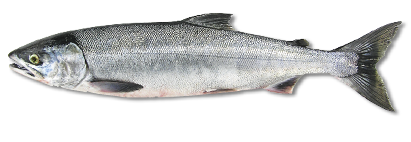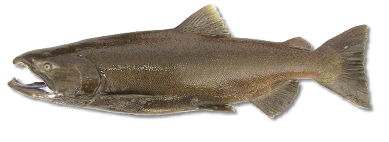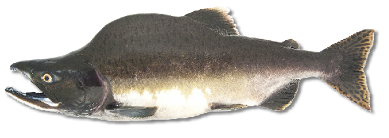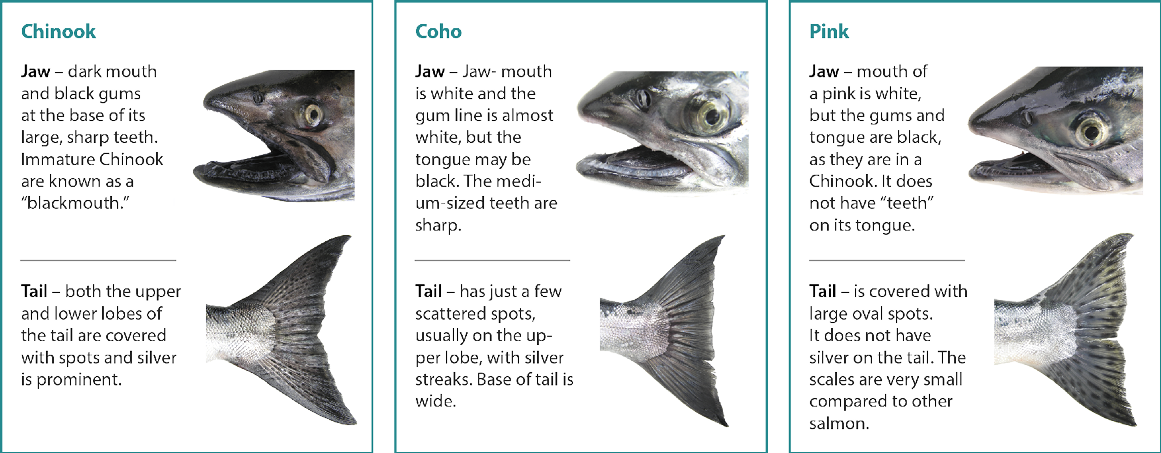Salmon Identification
Ocean Phase
Chinook Salmon

Large black spots on back, dorsal fin, and both the upper and lower lobes of the tail. Black mouth with a black gum line and large prominent teeth. Silver pigment on the tail.
Coho Salmon

Black spots on back with spots only on the upper portion of the tail. White mouth with a white gum line, a dark tongue, and medium-sized teeth. Average size scales. Silver pigment on the tail.
Chum Salmon

No prominent spots on back or tail (small speckles may be present). White mouth with a white gum line, a dark tongue, and well developed teeth. Calico markings (vertical bars), but faint on bright fish. Silver pigment on the tail.
Pink Salmon

Generally large black spots on back and heavy oval shaped black blotches on the upper and lower lobes of the tail. White mouth with a black gum line and tongue. Very small scales. No silver pigment on the tail. Few if any teeth present.
Sockeye Salmon

No prominent spots on back or tail (small speckles may be present). White mouth with a white gum line, a dark tongue, and almost toothless. Average size scales. Prominent gold-colored eyes. No silver pigment on the tail. Small teeth.
Spawning Phase
Chinook Salmon

Chinook salmon do not display the conspicuous morphological changes of pink, chum and sockeye salmon during the spawning stage. Typically Chinook turn from silvery bright ocean coloration to a darker bronze color. Large spots are found on the back and both lobes of the tail. Mouth is black with a black to grey gum line.
Coho Salmon

Mature coho salmon display a greenish-black head with a red to maroon colored body. Spots are found on the back and only upper lobe of the tail. The mouth is black with a white gum line. Typically male coho display brighter coloration and have a more pronounced elongated hooked snout.
Chum Salmon

Chum salmon display characteristic olive-green vertical markings on the sides of the body as they approach spawning. There are no spots on the back or tail. Male chum salmon develop a more elongated snout with large canine-like teeth and also have reddish-purple vertical markings in addition to the olive-green markings.
Pink Salmon

The majority of pink salmon return on odd-numbered years. Pink salmon have large oblong spots on the back and both lobes of the tail. Pink salmon, like most other salmon transform from silvery bright ocean coloration to a more dull and darker color. Males develop a pronounced hump as they approach spawning.
Sockeye Salmon

Sockeye turn brick red to scarlet red along their body with a greenish head. Female coloration is often more dull colored. There are no distinct spots on the back or tail. Sockeye can be found spawning in both lakes, streams, and rivers, while other Pacific salmon spawn in streams and rivers.
Learn more about Washington’s fish and wildlife by visiting the WDFW species and habitats page.
Atlantic Salmon

Atlantic salmon have large black spots on the gill covers and back, and rarely any spots on the tail fin. Their scales are large, there is no red stripe along the lateral line, and they have 8-10 anal fin rays. Atlantic salmon may be taken from marine waters during any open salmon season, and from anadromous (not landlocked) freshwater during any open salmon or trout season. Anglers may not, however, continue to fish for Atlantic salmon after a daily limit of another species of salmon has been retained. In landlocked lakes, Atlantic salmon may be taken as part of the trout daily limit. Seasons and size limits in place for trout apply to Atlantic salmon in landlocked lakes. Opportunities to harvest Atlantic salmon beyond those listed in the pamphlet will be announced to the news media. Please report sightings to (360) 902-2700.
Chinook, Coho, and Pink Salmon Identification

Wild and Hatchery Identification
In order to provide salmon and steelhead fishing opportunities, WDFW and the Tribes have marked salmon and steelhead by clipping the adipose fin (a small fatty fin directly behind the dorsal fin). In areas designated "release wild <insert fish name>", fin-clipped salmon and steelhead are the only fish that may be retained. The picture to the right shows a wild salmon and a fin-clipped or hatchery salmon. Please be careful in releasing wild fish– they are your fishing future! For tips on the best way to release fish, please see Fish Handling Rules. In Marine Areas 5-13, it is illegal to bring a wild salmon or a species of salmon aboard a vessel if it is unlawful to retain those salmon. "Aboard a vessel" is defined as inside the gunwale. In Marine Area 2-2, it is unlawful to totally remove salmon from the water if it is illegal to retain those fish, except anglers fishing from boats 30' or longer are exempt.
Learn more about hatchery programs and mass marking by visiting the WDFW mass marking and hatchery management page.



